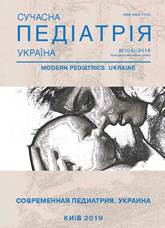Predicting the course of early onset neonatal sepsis in pretern infants
Keywords:
early onset neonatal sepsis, predicting, sTREM-1, pretern infantsAbstract
Early onset neonatal sepsis (EONS) remains the main cause of morbidity and mortality, especially among prematern infants. Therefore, development and practical application of effective model of EONS adverse effects prediction is a priority area for improvement of medical aid quality for this category of infants.The purpose. Improvement of care for prematurely born babies with EONS based on determination of predictive properties of sTREM-1 serum level and development of effective comprehensive algorithm for adverse effects prediction.
Materials and methods. Analysis of clinical laboratory observations for 42 newborns of gestational age 26–36 weeks (33 infants with EONS without shock and 9 infants with septic shock and/or death) with determination of serum content of sTREM-1 was carried out. Rank structures of indices were set and a prediction model was developed, when using Wald–Genkin heterogeneous sequential procedure.
Results. Newborns with shock and/or death had elevated sTREM-1 serum level >125.1 pg/ml. When developing a model of EONS adverse effects prediction, it was established that the highest predictive value is characteristic for sTREM-1 (I=3.03) and leukocytal intoxication index (I=2.97).
Conclusions. It was determined that the serum content of sTREM-1 in newborns with EONS >125.1 pg/ml in the 1st 24 hours of life is associated with further development of shock and/or death. High (>95.5%) reliability of the developed predictive multi-marker algorithm allows to recommend it for clinical use.
The research was carried out in accordance with the principles of the Helsinki Declaration. The study protocol was approved by the Local Ethics Committee of all participating institution. The informed consent of the patient was obtained for conducting the studies.
References
Adly AA, Ismail EA, Andrawes NG, El-Saadany MA. (2014). Circulating soluble triggering receptor expressed on myeloid cells-01 (sTREM-1) as diagnostic and prognostic marker in neonatal sepsis. Cytokine. 65(2);184–191. https://doi.org/10.1016/j.cyto.2013.11.004; PMid:24290866.
Alkan Ozdemir S, Ozer EA, Ilhan O, Sutcuoglu S, Tatli M. (2018). Diagnostic value of urine soluble triggering receptor expressed on myeloid cells (sTREM-1) for late0onset neonatal sepsis in infected preterm neonates. J Int Med Res. 46(4): 1606–1616. https://doi.org/10.1177/0300060517749131; PMid:29480083 PMCid:PMC6091820.
Arizaga-Ballesteros V, Alcorta-Garcia MR, Lazaro-Martinez LC, Amezquita-Gomez JM et al. (2015). Can sTREM-1 predict septic shock & death in late-onset neonatal sepsis? A pilot study. Int J Infect Dis. 30: 27–32. https://doi.org/10.1016/j.ijid.2014.10.013; PMid:25461656.
Bouchon A, Dietrich J, Colonna M. (2000). Cutting edge: inflammatory responses can be triggered by TREM-1, a novel receptor expressed on neutrophils and monocytes. J Immunol. 164(10): 4991–5. https://doi.org/10.4049/jimmunol.164.10.4991; PMid:10799849
Colonna M, Facchetti F. (2003). TREM-1 (triggering receptor expressed on myeloid cells): a new player in acute inflammatory responses. J Infect Dis. 187;2: 397–401. https://doi.org/10.1086/374754; PMid:12792857.
Derive M, Massin F, Gibot S. (2010). Triggering receptor expressed on myeloid cells-1 as a new therapeutic target during inflammatory diseases. Self Nonself. 1(3): 225–230. https://doi.org/10.4161/self.1.3.12891; PMid:21487478 PMCid:PMC3047784.
Dima M, Iacob D, Marginean O, Iacob ER. (2017). New emerging biological markers of neonatal sepsis. J Res Med Sci. 22: 65. https://doi.org/10.4103/jrms.JRMS_912_15; PMid:28616052 PMCid:PMC5461586.
Dower K, Ellis DK, Saraf K, Jelinsky SA, Lin LL. (2008). Innate immune responses to TREM-1 activation: overlap, divergence, and positive and negative cross0talk with bacterial lipopolysaccharide. J Immunol. 180(5): 3520–3534. https://doi.org/10.4049/jimmunol.180.5.3520; PMid:18292579.
Han L, Fu L, Peng Y, Zhang A. (2018). Triggering Receptor Expressed on Myeloid Cells-1 Signaling: Protective and Pathogenic Roles on Streptococcal Toxic-Shock-Like Syndrome Caused by Streptococcus suis. Front Immunol. 9: 577. https://doi.org/10.3389/fimmu.2018.00577; PMid:29619033 PMCid:PMC5871666.
Iroh Tam PY, Bendel CM. (2017). Diagnostics for neonatal sepsis: current approaches and future directions. Pediatr Res. 82(4): 574–583. https://doi.org/10.1038/pr.2017.134; PMid:28574980.
Kuzniewicz MW, Puopolo KM, Fischer A, Walsh EM et al. (2017). A Quantitative, Risk-Based Approach to the Management of Neonatal Early-Onset Sepsis. JAMA Pediatr. 171(4): 365–371. https://doi.org/10.1001/jamapediatrics.2016.4678; PMid:28241253.
Mukherjee S, Huda S, Sinha Babu SP. (2019). Toll-like receptor polymorphism in host immune response to infectious diseases: A review. Scand J Immunol. 90(1): e12771. https://doi.org/10.1111/sji.12771; PMid:31054156
Puopolo KM, Benitz WE, Zaoutis TE. (2018, Dec). Management of Neonates Born at <34 6/7 Weeks' Gestation With Suspected or Proven Early-Onset Bacterial Sepsis Pediatrics. 142(6). pii: e20182896. https://doi.org/10.1542/peds.2018-2896; PMid:30455344
Saldir M, Tunc T, Cekmez F, Cetinkaya M et al. (2015). Endocan and Soluble Triggering Receptor Expressed on Myeloid Cells-1 as Novel Markers for Neonatal Sepsis. Pediatr Neonatol. 56(6): 415–421. https://doi.org/10.1016/j.pedneo.2015.03.006; PMid:26341458.
Stein M, Schachter-Davidov A, Babai I, Tasher D, Somekh E. (2015). The accuracy of C-reactive protein, procalcitonin, and s-TREM-1 in the prediction of serious bacterial infection in neonates. Clin Pediatr (Phila). 54(5): 439–444. https://doi.org/10.1177/0009922814553435; PMid:25294884.
Tammaro A, Derive M, Gibot S, Leemans JC et al. (2017). TREM-1 and its potential ligands in non-infectious diseases: from biology to clinical perspectives. Pharmacol Ther. 177: 81–95. https://doi.org/10.1016/j.pharmthera.2017.02.043; PMid:28245991.
Zhu H, Li W, Wang Z, Chen J et al. (2019). TREM-1 deficiency attenuates the inflammatory responses in LPS-induced murine endometritis. Microb Biotechnol. 12(6): 1337–1345. https://doi.org/10.1111/1751-7915.13467; PMid:31365951 PMCid:PMC6801141.
Downloads
Issue
Section
License
The policy of the Journal “MODERN PEDIATRICS. UKRAINE” is compatible with the vast majority of funders' of open access and self-archiving policies. The journal provides immediate open access route being convinced that everyone – not only scientists - can benefit from research results, and publishes articles exclusively under open access distribution, with a Creative Commons Attribution-Noncommercial 4.0 international license (СС BY-NC).
Authors transfer the copyright to the Journal “MODERN PEDIATRICS. UKRAINE” when the manuscript is accepted for publication. Authors declare that this manuscript has not been published nor is under simultaneous consideration for publication elsewhere. After publication, the articles become freely available on-line to the public.
Readers have the right to use, distribute, and reproduce articles in any medium, provided the articles and the journal are properly cited.
The use of published materials for commercial purposes is strongly prohibited.

